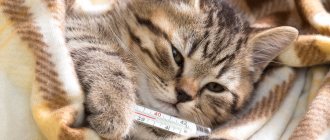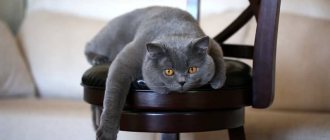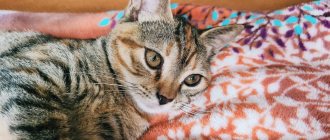Possible causes and additional symptoms
If your cat's paw is swollen and he cannot step on it, you should try to determine the cause at home. Edema can be localized or general: in the first case, it does not extend beyond a limited area, in the second, the animal’s entire limb swells completely.
cat paws
For your information! Most often we are talking about one paw, but often two or four limbs swell, which is why the animal is not able to move normally.
Joint inflammation
When joints become inflamed as a result of arthrosis or arthritis, the limbs swell locally, which is accompanied by severe pain. A cat may limp on one or more legs if arthritis affects more than one limb. More often, joints become inflamed in older animals whose mobility is limited.
Allergic reaction
If a cat has a tumor on its paw, the cause may be an acute allergic reaction. Most often this occurs due to insect bites; the swelling in this case is very large and is accompanied by pain in the limb. The pet is given antihistamines after consultation with a veterinarian.
Cancer tumor
Breast cancer can also cause your cat to have a very swollen paw pad or entire limb. The tumor can fester or swell; this occurs due to the blockage of the flow of lymph in the vessel and its stagnation.
How is a veterinarian examined?
Note! The swelling will be localized on the side where the cancer began to develop.
Swelling after catheter
It is not uncommon for a cat's paw to swell after a catheter is inserted if the cat is being treated for a medical condition. Staying on a drip for a long time has its side effects and can lead to swelling where the needle is inserted.
Venous insufficiency
Constant swelling of the limbs is a signal of venous insufficiency, from which the animal most likely suffers. Without treatment, this pathology can lead to acute blockage of blood vessels, subsequent necrosis, amputation of the paw and even death. For venous diseases, the cat requires treatment and observation under the supervision of a specialist.
Fungal infection
Mycoses can also cause edema, severe lameness and swollen limbs in cats. Most often they develop due to weakened immunity. If your cat has a swollen paw, you should check the animal for a fungal infection, symptoms of which include peeling and itchy skin, dandruff and an unpleasant odor.
Injury
If your cat's hind legs are swollen, injuries are often to blame. The animal may have a fracture or dislocation, causing swelling. A clear sign is limping on one or both legs, redness at the site of swelling, increased temperature, damaged skin and the presence of wounds.
Lymphadenitis
Lymphadenitis or inflammation of the lymph node also causes swelling, most often in the armpits or forelimbs. The lymph node enlarges and becomes painful when pressed. Lymphadenitis often accompanies various pathologies, for example, infectious diseases.
Hyperparathyroidism
This disease mainly occurs in kittens in the first weeks after birth. Its cause is a disruption in the production of hormones. If your kitten has a swollen front or back leg, it most likely has hyperparathyroidism.
For your information! In addition to swelling, the disease is accompanied by lameness and muscle pain.
What to do in an emergency?
In case of injury or after surgery, the owner should know how to provide first aid to the pet:
- If a cat's hind legs are swollen after anesthesia, and the sore spot is hot when touched, it may be thrombophlebitis. You should lubricate the limb with Troxevasin liniment and take the pet to the veterinary clinic.
- If you have tightened your paw with a clamp, you need to loosen it a little so that blood circulation is restored and the swelling goes away.
- In case of a bruise, you should apply a cold compress, alternating for 15 minutes, which will help relieve pain and prevent the development of swelling.
The sore limb of the fluffy needs to be secured with a bandage.
For fractures and dislocations, the algorithm for assistance is as follows:
- Provide rest to the limbs and limit the cat’s mobility.
- Apply a cold compress.
- Secure the paw with planks, making a soft spacer between the skin and the clamp.
- Apply a bandage, not too tight.
First aid if your paw is swollen
When a cat's paw is swollen and he is limping, you need to know exactly what to do in order to quickly provide first aid to the animal. The pet is examined for wounds and bruises. If you have them, you can treat them at home yourself. In severe cases, it is better to contact a veterinary clinic. Standard care for wounds and minor blisters includes:
- rinsing with chlorhexidine and hydrogen peroxide;
- treating the skin around the injury with iodine or alcohol;
- applying a bandage soaked in levomekol or ichthyol ointment.
The cat lost his voice: reasons and what to do
Since limbs can swell for many reasons, do not put off visiting the veterinarian. It is not so difficult to find a suitable specialist; it is important that the examination is carried out on time and treatment is prescribed as soon as possible.
Cats also get plaster casts.
Note! After prescribing treatment, the owner will need to provide the pet with the necessary care, bandage it, give medications and follow a schedule.
How to treat inflammation of the periosteum of a tooth before visiting a doctor?
Self-medication for any purulent processes is very dangerous, so it is recommended to consult a dentist at the first symptoms of the disease. However, before visiting a doctor, the patient can alleviate his condition somewhat by applying cold to the cheek on the affected side and rinsing his mouth with an antiseptic solution at room temperature (chlorhexidine soda-saline solution, chamomile or sage decoctions). Here's what you absolutely can't do:
- Apply warm compresses and drink hot drinks.
- Apply any bandages yourself or use medications without a doctor’s prescription.
- It is better not to take analgesics before visiting the dentist.
- If you are undergoing surgery (opening an abscess), you should not take aspirin, since it changes the rheological properties of the blood and can cause bleeding.
Diagnostic methods
Regardless of the cause of the edema, it is always necessary to carry out diagnostics, which are done in an inpatient setting. This should be done by a doctor, after an examination he will be able to make an accurate diagnosis. Diagnostics helps to find out what caused the swelling, especially if it is impossible to identify visible damage and recognize the causes of the symptoms. Primary diagnosis includes a standard external examination of the limb and the animal as a whole.
The cat is limping on its front leg without visible damage
Important! It is necessary to carry out a diagnosis in any case; you should not treat your pet at home on your own without a veterinarian. This is fraught with negative consequences and deterioration of the animal’s condition.
X-ray of paws
After an external examination, blood and other body fluids are tested and, if necessary, a cardiogram is performed to evaluate the functioning of the heart. To assess damage to a limb, your doctor will perform an MRI or X-ray to check for fractures, dislocations, and bruises. If the diagnosis is confirmed, the swollen limb is treated and treatment is prescribed.
Description of the drug Bonharen
The active substance of the drug is hyaluronic acid (in the form of sodium hyaluronate), which is the main element of cartilage tissue and synovial fluid. According to research, with inflammatory changes in the joints, its content decreases, which leads to disruption of the viscosity of the synovial fluid and the strength of chondrocytes. Additional administration of hyaluronic acid for arthritis in animals helps to compensate for its deficiency and reduce the wear and tear of the joint.
The main indications for prescribing Bonharen to cats are:
- acute and chronic arthritis/polyarthritis;
- osteoarthritis;
- arthrosis;
- tendovaginitis;
- bursitis.
The drug is also used for inflammation and injury to the eyeball in animals in order to restore normal metabolism in the organ.
Release form: sterile solution for subcutaneous or intravenous administration. Sold in ampoules of 2 and 6 ml. There are 3 ampoules in the package.
Recommended dosage for cats:
- with a weight of less than 5 kg – 0.1 ml/kg, which corresponds to 1 mg/kg;
- with a weight of more than 5 kg - 0.05 ml/kg, which corresponds to 0.5 mg/kg.
When administered parenterally, the effect of Bonharen is observed after 4 hours, and the total period of activity is 2-3 days. The course of application is from 3 to 7 injections, which must be performed every 5-7 days. The drug can be prescribed to pregnant and lactating cats. There are no contraindications to it. As a side effect, veterinarians note the appearance of a local reaction to the injection, which manifests itself as swelling and disappears after 1-2 days.
How is the treatment carried out?
The pet must be treated according to the system chosen by the specialist, taking into account the diagnosis. A limb can swell for many reasons, so the owner should take care of preliminary diagnosis and do it as soon as possible. If the swollen paw is very inflamed, the problem is most likely an infection. In this case, the animal requires antibiotics or even surgical care.
The dog's muzzle is swollen on one side: causes
Important! You can alleviate his condition before going to the clinic with the help of cold compresses.
If you have an allergy, give an antihistamine tablet; a fungal infection will require urgent use of an antifungal agent. When swelling appears due to venous stagnation, arthritis, kidney disease, heart disease or liver disease, the underlying disease must first be treated. You should not try to treat your pet yourself or give it medications without first consulting a specialist. Edema is a symptom of many serious diseases that require urgent treatment.
Video
Why can the periosteum of a tooth become inflamed?
The most common is odontogenic periostitis of the jaws, that is, an inflammatory process provoked by diseases of the teeth or periodontal tissues. Deep caries, pulpitis, periodontitis (inflammatory process at the apex of the tooth root), periodontitis - all these diseases, if not treated in time, lead to the appearance of gumboil. Also, one of the reasons for the development of the inflammatory process may be alveolitis - inflammation of the tooth socket, which in some cases occurs after tooth extraction. Inflammation of the periosteum after tooth extraction usually develops in those patients who do not rush to see a dentist when the first signs of complications appear in the postoperative period.
Much less common is toxic periostitis, caused by infection through the blood or lymph (usually due to some general infectious disease). The disease can also be caused by injuries to the jaw bone or surrounding soft tissue.
General signs of illness
Not all diseases of British cats can be detected at an early stage. But if you carefully observe your pet, you will notice that he is not feeling well.
Signs of illness:
- lethargy, drowsiness;
- refusal to eat or loss of appetite;
- deterioration in the condition of the coat - it looks unkempt and loses its healthy shine;
- stool disorders - diarrhea or constipation;
- vomit;
- discharge from the nose, eyes;
- unsteadiness of gait or lameness;
- the cat walks with its mouth open and tongue hanging out;
- difficulty or rapid breathing;
- wheezing.
If at least one of the listed symptoms is detected, you need to examine the Briton and measure his temperature. If the thermometer is above 39 degrees or below 37.5, the cat needs to be taken to the vet immediately.
Patient care
An extremely unpleasant ailment, which causes not only pain, but also great inconvenience to the cat, requires increased attention from the owner and all family members. In addition to medications, the patient must be provided with comfortable living conditions and maximum care.
Arrangement of resting and feeding areas
You should start with a bed, which should be medium soft and quite spacious. The sleeping place should not be placed at a height, as the patient risks falling and receiving additional injuries. The best place for placement is the floor. However, you need to place the bed so that the cat is warm and there are no drafts below.
Bowls with food and water are placed near the crib. This is also done for the safety of the patient. You need to buy a tray with low walls so that you don’t have to lift up the highly injured legs. The filler used is small, it is poured in a thin layer. Then the cat will be able to fit comfortably in it.
Some felines like to sleep at heights. This is extremely dangerous, so it is worth blocking the path to the closet, window or refrigerator with boxes so that your mustachioed friend cannot jump into his usual place. Due to the constraint of movements, it is difficult for the pet to practice hygiene, so you need to comb the cat at least 2 times a week and trim the tips of the claws.
Painful sensations do not allow the mustachioed friend to enjoy communication with the owner. Indeed, the manifestation of affection in the form of hugs, throwing up, lifting by the paws is now under the strictest prohibition. Active games, fun and pranks with the patient are also prohibited.
Diet as the key to joint health
In addition to the measures listed, it is important to adhere to a special diet. This is especially necessary for individuals who are obese. Typically, the veterinarian recommends special medicinal industrial wet or dry food of premium class and higher, or natural, complete food with low calorie content. The menu should include:
- lean meats: chicken fillet, turkey, veal, beef, rabbit;
- sea, lean fish with a small number of bones;
- fermented milk products with low fat content or completely fat-free;
- boiled, chopped vegetables;
- cereals cooked in the form of porridge in water;
- cartilage, fresh gelatin broths.
You cannot offer cats food from the owner's table, tubular bones, sweets, salty or smoked foods, or milk.
Prevention
To prevent the development of pododermatitis, it is important to constantly examine the animal’s paws, even if the cat is black, the disease will be visible by peeling and unnatural dryness. As a preventive measure, it is recommended to wash the cat’s paws with disinfectants, not let him go outside during the cold season, and increase the body’s protective functions. If there are characteristic symptoms, do not self-medicate, but urgently take your pet to the hospital. If diagnosis and treatment are timely, complications can be avoided.











